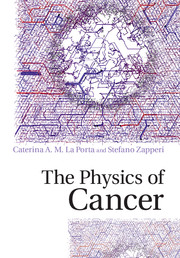Book contents
- Frontmatter
- Dedication
- Contents
- Preface
- 1 Introduction to the Cell
- 2 The Biology of Cancer
- 3 A Modeling Toolbox for Cancer Growth
- 4 Vascular Hydrodynamics and Tumor Angiogenesis
- 5 Cancer Stem Cells and the Population Dynamics of Tumors
- 6 Biomechanics of Cancer
- 7 Cancer Cell Migration
- 8 Chromosome and Chromatin Dynamics in Cancer
- 9 Control of Tumor Growth by the Immune System
- 10 Pharmacological Approaches: Old and New
- 11 Outlook on the Physics of Cancer: A New Interdisciplinary Area
- References
- Index
5 - Cancer Stem Cells and the Population Dynamics of Tumors
Published online by Cambridge University Press: 04 May 2017
- Frontmatter
- Dedication
- Contents
- Preface
- 1 Introduction to the Cell
- 2 The Biology of Cancer
- 3 A Modeling Toolbox for Cancer Growth
- 4 Vascular Hydrodynamics and Tumor Angiogenesis
- 5 Cancer Stem Cells and the Population Dynamics of Tumors
- 6 Biomechanics of Cancer
- 7 Cancer Cell Migration
- 8 Chromosome and Chromatin Dynamics in Cancer
- 9 Control of Tumor Growth by the Immune System
- 10 Pharmacological Approaches: Old and New
- 11 Outlook on the Physics of Cancer: A New Interdisciplinary Area
- References
- Index
Summary
According to the CSC hypothesis, tumor growth is driven by a small population of cancer stem cells which can self-renew and differentiate into cancer cells with a long but limited lifespan. The experimental challenges in the identification of CSCs are discussed in Section 5.1 where we review the relevant biological markers. In Section 5.2, we discuss the population dynamics within the tumor, composed by CSCs and other tumor cells. To this end, we introduce a mathematical model for the evolution of the populations and compare its results with experiments. In Section 5.3, we deal with the possibility that cancer cells can occasionally switch back to the CSC state, discussing relevant experiments and models. Section 5.4 is devoted to the issue of cell sorting. While one would like to define the CSC population in a sharp way, in practice the boundary is fuzzy, being based on the expression of biological markers which are by their nature imperfect. This opens an interesting issue about the interpretation of the experimental results.
Experimental Identification of Cancer Stem Cells
Tumor growth can either be described by the conventional model or by the CSC theory. According to the first model, cancer cells are heterogeneous but are all tumorigenic, while the CSC hypothesis states that in the tumor there is a subpopulation sustaining the tumor growth (La Porta, 2009). Cancer stem cells (CSCs) are a subpopulation of tumor cells that possess the stem cell properties of selfrenewal and differentiation. Therefore, a CSC is a cell within the tumor that has the capacity of self-renewing and generating a heterogeneous population of cancer cells composing the tumor. Contrary to normal stem cells, however, which control very strictly their proliferation capability and try to carefully maintain their genomic integrity, CSCs typically lack any control of those processes. Identifying differences between normal stem cells and CSCs is important for understanding how cancers progress and could possibly result in new therapies to fight cancer. In practice, CSCs can only be defined experimentally by their ability to recapitulate the generation of a continuously growing tumor. To this end, putative CSCs are identified according to the expression of surface markers (e.g., factors expressed by normal stem cells) and isolated through fluorescence-activated cell sorting (FACS).
- Type
- Chapter
- Information
- The Physics of Cancer , pp. 68 - 80Publisher: Cambridge University PressPrint publication year: 2017

